Whether it be a puncture or riding so much that you wear the tyres out, there will come a time when you need to remove the tyres and inner tubes of your Mi Electric scooter. If its your first time it can be a daunting and complex procedure. In this article we’ve documented the approach we use for removing / replacing the tyres and inner tubes on the scooter.
Disclaimer : as ever anything you do to your scooter is your responsibility. RC Geeks cannot accept liability for any damage caused to you or your scooter as a result of following our methods.
This is a difficult task and we aren’t here to sugar coat it, but here are some tips that might help (if you don’t have time to read this article):
If you really can’t manage it, consider approaching your local bike shop. An experienced bicycle mechanic should be able to help you.
Some specialist tools are required to make this job straightforward:
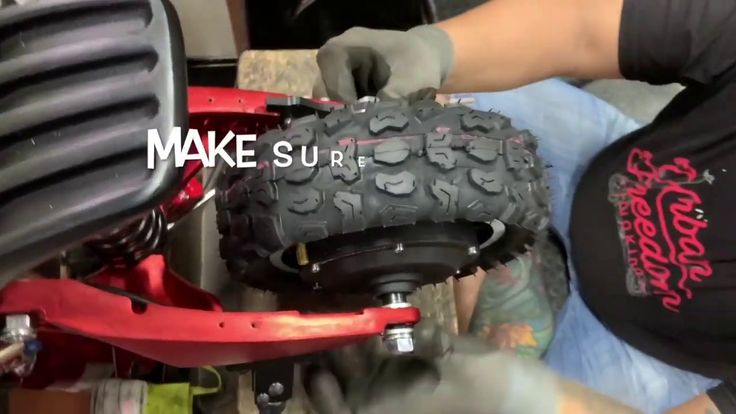 5mm hex driver
5mm hex driverYou potentially have some bicycle tyre levers at home. You might think they will do the job. With enough straining and swearing you might just get away with it. Instead, pick up a set of these foot-long metal ones (designed for fitting motorcycle tyres) from eBay to make your life easier.
In our experience this is the wheel that seems to get more punctures, thankfully it is the ‘easier’ one to work with.
1. Position the scooter so you can work on it comfortably, fold it and place it upside down or on its side (disc side down) on a work-surface.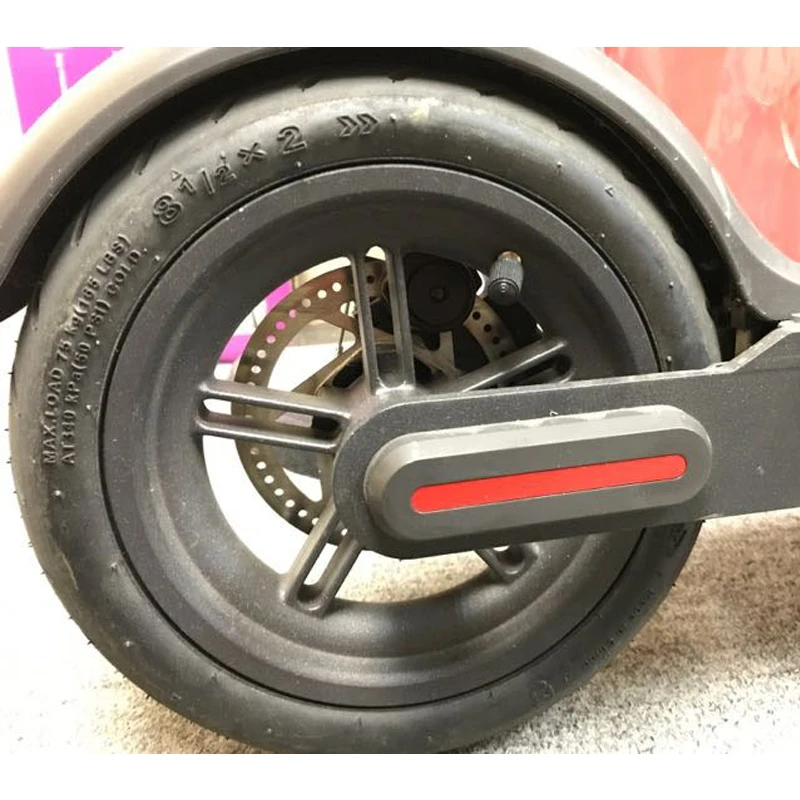 Remove the valve cap and put it safely to the side. Use a tool to deflate the inner tube, squeezing the tyre to try and get as much air out as possible.
Remove the valve cap and put it safely to the side. Use a tool to deflate the inner tube, squeezing the tyre to try and get as much air out as possible.
2. Take a scalpel or pick and remove the plastic trim strip (the whole piece, not just the top red sticker label) from the rear screw cover.
3. Once clear, use the 2.5mm hex driver to remove the two screws that hold the trim piece on. Pop the trim piece off and put these parts aside.
4. Take the allen/4mm hex driver and unscrew (counter-clockwise) the axle bolt. Keep this, the spring washer and flat washer safe. You should have removed all these pieces so far.
5. With the wheel still attached, squeeze the tyre and slip the tyre lever under the bead.
6. Rotate the wheel bracing the lever off of the frame of the scooter to release the bead from the wheel lip, this will take some force.
7. Once it is around a third released you can use your hands to man-handle the tyre all the way off on one side.
8. Flip the scooter over (or move to the other side) and repeat the process to remove the trim piece, the two cap-head 2.5mm bolts and finally the other 4mm axle bolt
9. Slide the wheel straight back out of the scooter. It might need to be wiggled to clear the brake caliper. Note the flats on the axle for locating it, important to remember when refitting later.
10. With the wheel out you can pull the tyre over to one side, allowing you pop the inner-tube free and then the wheel itself.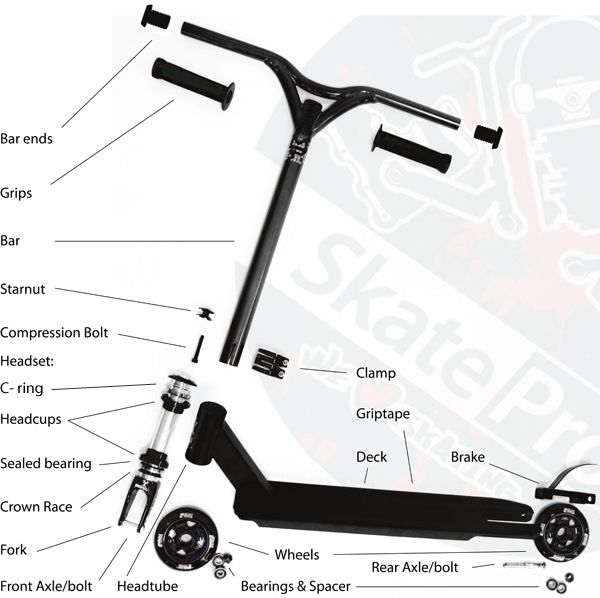 This will take some grip strength, especially if the tyre is cold. Try not to work with the disc-side-down as it is easy to bend the disc, making it rub on the pads as it rotates.
This will take some grip strength, especially if the tyre is cold. Try not to work with the disc-side-down as it is easy to bend the disc, making it rub on the pads as it rotates.
11. Finally wiggle the inner tube valve out of the wheel to free it. Your patience will be rewarded after a few minutes of fiddling. Pushing from the valve side can work if you are struggling.
12. The inner tube valve is designed with a slight offset to match the wheel. Orientate the wheel to match this.
13. Push the valve through the rim and secure it with the valve cap to prevent it from falling out again.
14. if you are replacing the tube due to puncture, take some time to check the inside of the tyre to ensure there is nothing inside that will harm the new inner tube. Next orientate the tyre so the tread is facing the correct direction. With the brake disc ‘up’ the tyre rotates anti-clockwise as denoted by the arrows next to the sizing numbers on the sidewall seen in the photo below:
Next orientate the tyre so the tread is facing the correct direction. With the brake disc ‘up’ the tyre rotates anti-clockwise as denoted by the arrows next to the sizing numbers on the sidewall seen in the photo below:
15. Squash the tyre into an oval shape and insert the wheel and tube into it.
16. Gently tuck any excess inner tube in with your hands. Pull the lip of the tyre back from the wheel body to check the tube is clear of the lips on both sides to avoid a pinch flat. Twist the tyre until you seat the ‘rear’ bead on the disc side. A lever can help here but it is possible with your bare hands.
17. Re-insert the wheel into the frame, taking note of the keying to slide it in. Install the axle bolts top and bottom and screw them tight with just your fingers.
18. Rotate the tyre so the valve is close to the footplate. Insert the lever under the tyre lip and rotate the wheel anti- clockwise to jam the tool up against the frame.
19. Use both hands to continue rotating the wheel anti-clockwise, slipping the bead back under the lip until complete. The resistance will increase as you turn it. If you find the tyre wants to ‘pop off’ the wheel you can use cable ties run around the tyre and between the spokes to secure sectors of the tyre as you work around.
20. Replacement of the screws and trim is the reversal of removal. Tighten but do not over-torque the axle bolts, use hand tools only. Remove the valve cap and inflate to your required pressure.
The motor wheel is more difficult to work on. Unless you go to extreme lengths you will be working on it whilst tethered to the frame (via the power cable) and there are no spokes to help grip the wheel.
1. Position the scooter so you can work on it comfortably, fold it and place it upside down or on its side wire-motor-side-up on a work-surface. Using the pick remove the ‘u’ trim (not just the sticker but the whole piece).
02. Next use your wrench to remove the four 2.5mm cap head bolts and remove the plastic axle cover. Remove the valve cap and let down the tyre.
03. Use the same wrench to remove the four short 2.5mm cap head bolts that hold the plastic fork trim to the metal forks.
04. Lifting the plastic trim away from the fork, use the 18mm open end of your spanner to loosen the wheel nut. It un-does in an anti-clockwise, lefty-loosey fashion but we had to use some WD40 (and let it soak for a few minutes) to get ours to move.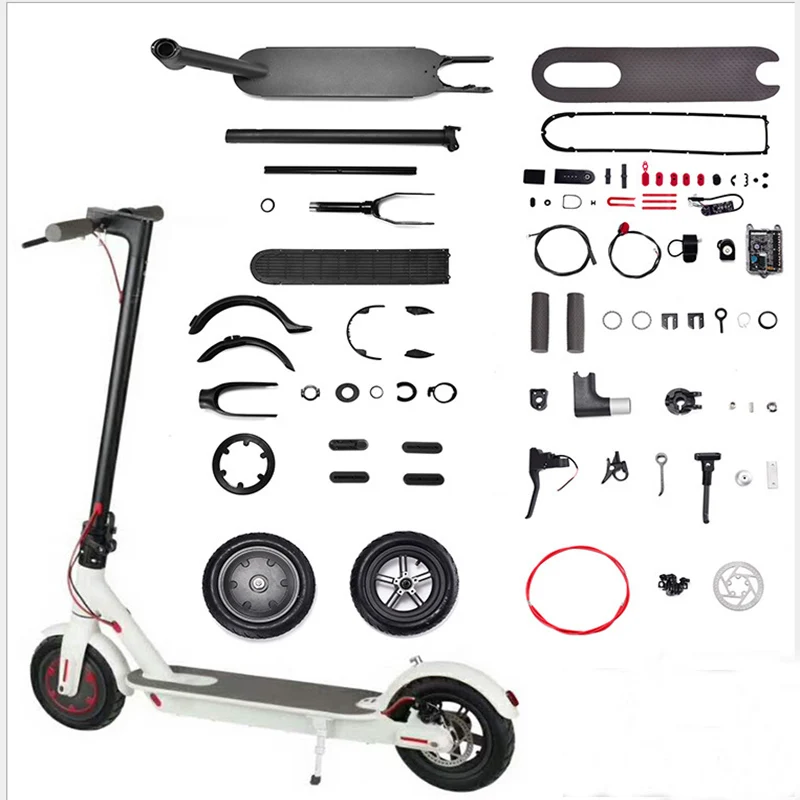
05. Slip the nut through the trim and slide it up the wire out of the way.
06. Use the pick to release the cable grommet on the frame, this will allow some more slack in the wire to give you more room to work.
07. Flip the scooter over and use the pick to remove the trim. Use your driver to remove the two 2.5mm cap bolts, the plastic trim and the four 2.5mm short cap bolts underneath.
08. Lifting the fork plastic you can use the ring end of your spanner (if it has one) to remove the 18mm wheel nut. Again rotate anti-clockwise to loosen and use WD40 or a penetration fluid to help.
09. Here is a reminder of what you have taken off this side and the tools required, note the keyed washer is still on the axle in this photo.
l0. Note the tabbed wheel washer, its orientation must be noted when re-inserting.
11. With the wheel wire-side-up (to avoid stressing it) insert your levers under the top wheel lip and rotate them over to release the bead. Work one of them around the rim lip to completely release one side.
12. Using your hands (or with some help from the levers) pull the tyre off of the rear of the wheel.
13. Take time to wiggle the valve out of the front wheel. This can be harder than you think but your patience will be rewarded. If the inner-tube is already compromised it can be quicker just to cut it away around the valve stem to remove it.
14. Re-inserting the new inner-tube can be a challenge of its own and was the most frustrating part of putting this guide together.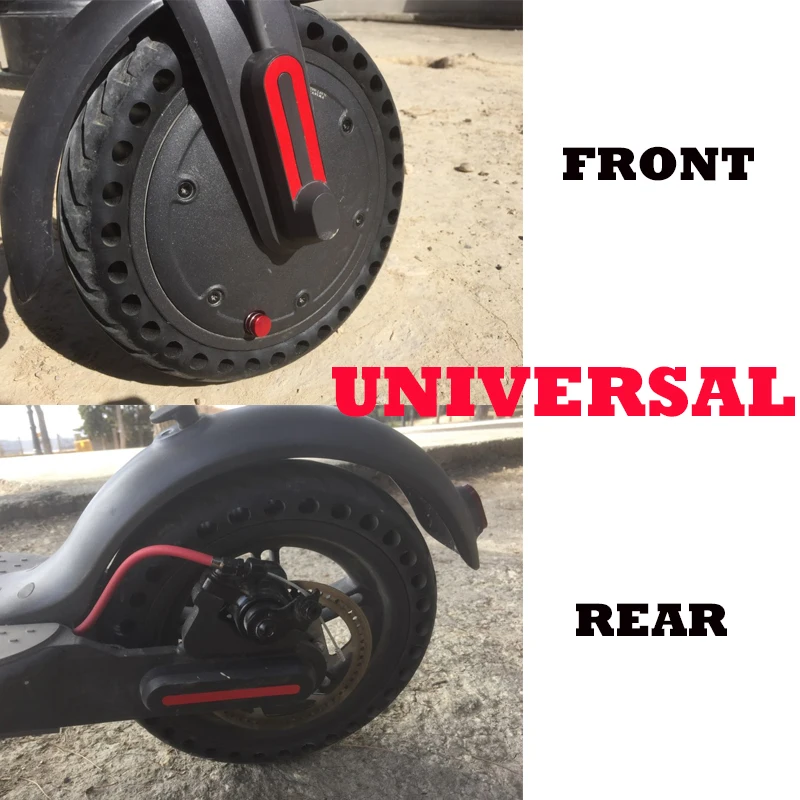 Some lubrication can assist. The tolerances of the valve ‘window’ in the wheel can be incredibly tight. Many users have opened up the plastic ‘floating’ portion of this hole using a rotary tool to make life easier but we suggest avoiding such destructive actions if you can. Once the valve is through, cap it and spread the tube around the rim.
Some lubrication can assist. The tolerances of the valve ‘window’ in the wheel can be incredibly tight. Many users have opened up the plastic ‘floating’ portion of this hole using a rotary tool to make life easier but we suggest avoiding such destructive actions if you can. Once the valve is through, cap it and spread the tube around the rim.
15. Working on a tyre that is slightly above room temperature (leave it by a radiator for some time prior) will make this job easier. Ensure you have the tyre orientated correctly when refitting. With the wheel motor-cable facing-up the tread should point ‘clockwise’ around the tyre. To get started, stand the wheel up, squeeze the tyre from the sides into an oval and press it over the top of the wheel passing the wheel through so the tyre is now hooked over the wire.
16. Use the lever to pop the rear (non-cable) side bead onto the lip. Take time to tuck the tube in, making sure it does not get pinched by the tyre bead on the rim lip.
Use the lever to pop the rear (non-cable) side bead onto the lip. Take time to tuck the tube in, making sure it does not get pinched by the tyre bead on the rim lip.
17. A second pair of hands will help with the last part. As you lever the top side bead onto the lip you will find that the tyre tries to resist you, rotating and popping the previously seated rear off. Slip one side of the bead on and ask an assistant to hold the lever in place whilst you work around the wheel. It may take a few attempts but you will get there.
18. Replacement of the screws and trim is the reversal of removal. Tighten but do not over-torque the axle bolts, use hand tools only. Inflate the tyre and install the valve cap.
Watch where you ride! But seriously a common preventative step is to add ‘tyre slime’ tube sealant (before you have a puncture). This will fill out and reseal an inner tube should it get punctured. Beyond this, riding with the correct tyre pressures for passenger weight is important, as listed in our article here. Oh and of course don’t forget to inspect your tyres carefully for any ‘foreign bodies’ before fitting a new tube.
This will fill out and reseal an inner tube should it get punctured. Beyond this, riding with the correct tyre pressures for passenger weight is important, as listed in our article here. Oh and of course don’t forget to inspect your tyres carefully for any ‘foreign bodies’ before fitting a new tube.
Yes we do. If you need any spares or accessories for your scooter check them out on our webstore. We don’t sell solid tyres as (at time of press) we don’t rate the solutions currently on the market.
Sadly we are currently unable to offer a tyre/puncture service for electric scooters. Your local bike shop may be willing to attempt the work if you show them what is involved with this article.
Interested in buying the ‘original’ electric scooter? Then we do have to ask why you are on this article! Try this one instead. Looking for some accessories for your Electric Scooter? Check our article for some suggestions.
Looking for some accessories for your Electric Scooter? Check our article for some suggestions.
We know this isn’t the only (or perhaps even the best) way of approaching this job. If you have any suggestions for improvements, shortcuts or tricks, let know in the comments section below.
Previous | Next
If you live in a place where your Xiaomi electric scooter is likely to get punctures very often, you may want to upgrade the wheels to solid tires. This is especially the case for those who live in rural areas or do not have tarmacked driveways or roads. Upgrading to a solid tire will save you a lot of energy and expensive tubes too.
Pros:
They do not get punctures. This is pretty much the only real advantage of solid tires.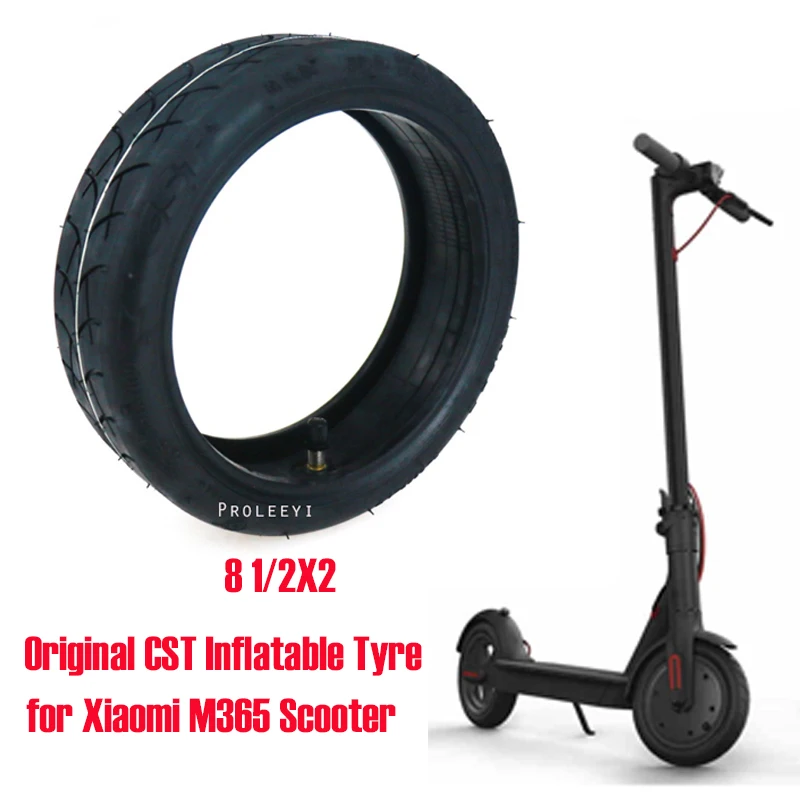
Cons:
Your new solid tire for your electric scooter may have more or less rolling reluctance which means that your scooter will use more energy and battery power. The energy spending or conservation will largely depend on how well you fix the tire, and whether you have the right one for the job.
Solid tires may also be a little difficult to mount on the rim of the wheel since they can be too tight or loose. This, however, can be solved by softening it before fitting (this will be explained further in the fitting instructions). The Xiaomi electric scooter tire size is 8.5 inches in diameter and 2 inches thick.
Additionally, Xiaomi M365 electric scooters do not have shock absorbers. With the lack of its pneumatic tires, this means that the scooter may experience a lot of vibrations during the ride. The movements may loosen bolts and nuts which may cause parts and cables to loosen and fall apart in the future so pay attention and maintain your Xiaomi M365 scooter.
Steps to follow:
 This should manage the amount of friction that will be involved during the fitting.
This should manage the amount of friction that will be involved during the fitting.Make sure that you purchase your Xiaomi electric scooter parts from a trusted distributor. This will minimize the chances of buying counterfeit or low-quality parts, spares, and tools.
This will minimize the chances of buying counterfeit or low-quality parts, spares, and tools.
Please enable JavaScript to view the comments powered by Disqus.
Wheels are an important part of an electric scooter. They determine the main technical characteristics of the device: the allowable user weight, terrain, maximum speed, etc. The diameter of the wheels is responsible for the cross-country ability and maneuverability of the vehicle, and their rigidity is responsible for traction with the road surface. Moreover, even such parts are not durable and need to be replaced or banal cleaning for better functioning. Next, we will look at how to remove the wheels on an electric scooter and in what cases this procedure is necessary.
Next, we will look at how to remove the wheels on an electric scooter and in what cases this procedure is necessary.
A regular or folding electric scooter requires regular diagnostics and troubleshooting. This applies not only to the controller, but also to other details. The procedure for changing wheels is really important. It is recommended that every owner of electric transport know about the sequence of actions in order to prevent adverse consequences.
Whether it's an 8", 12" or any other diameter wheel, the replacement instructions are the same, so you don't need to look for additional information.
The need to change the wheel occurs in two situations :
Wrong or defective wheels make the scooter uncomfortable to use. In addition, they often cause falls.
In most cases, users are unlucky with wide wheels, because such an electric scooter is more difficult to control.
The owner of the device has to determine the frequency of wheel replacement independently. But it is important to learn a few points:
The procedure for changing a wheel is not too complicated, but one tool is not enough. You will first need to prepare:
The list of tools is the same, regardless of the diameter of the wheels and other parameters.
If you need to remove two wheels, do not rush. Although there are no particular difficulties in this process, the front and rear elements have some differences in their designs, and therefore each of them requires an “individual approach”. Consider the sequence of actions in the case of removing the front and rear wheels.
The same instructions can be used for an electric scooter with cast wheels.
Removing the front wheel on an electric scooter is easy even for beginners. All the small elements that need to be removed are in prominent places, so you won’t need to look for them and perform complex manipulations.
The electric scooter must be switched off before removing the wheel.
Consider the removal process using the example of device Mijia Xiaomi M365 . The instructions here are:

You can remove the rear wheel on an electric scooter according to the instructions above. Both wheels of the vehicle are mounted, removed and installed in the same way. This is done using the same tools.
You don't need to be a high-class craftsman to remove the wheel motor. Here you will need to show your own accuracy and care. The user will not only have to follow the instructions in the process of unscrewing the rear wheel, but also monitor all the removed elements - nuts, screws, linings, etc. Having lost at least one detail, the device is not recommended to be used in the future without it.
In the process of removing the motor-wheel, be aware of the wire attached to it, which is undesirable to damage, so you need to do it carefully.
No tools are required to remove the tire. In this case, the user will only need their own hands and patience.
You can remove the tire from the electric scooter as follows:
It is possible to remove the tube from the electric scooter only after the wheels have been removed from the vehicle structure. This is necessary in cases of puncture or simple diagnosis.
The sequence of actions for is:
It is possible to replace the camera at home, but it is important to buy an element of the right size for installation in the wheel - for this it is recommended to take the damaged camera with you to the store and show it to the seller.
Repair work does not begin with the removal of the wheels, but with their disassembly. A correctly performed procedure will help to avoid the appearance of new breakdowns and quickly see the cause of an existing problem. At the same time, it will be easy for a user without skills to cope with both thick wheels and thin ones. The most important thing is to be careful, because small parts are easy to damage or lose.
It is possible to dismantle the front wheel on an electric scooter in just 5 minutes. This is done as follows:
You can disassemble the rear wheel of the electric scooter according to the same instructions as for the front element. In such devices, they have the same size, and therefore it will not be difficult to cope with the task.
In such devices, they have the same size, and therefore it will not be difficult to cope with the task.
Some users mistakenly believe that only a real master can disassemble the motor wheel. In fact, you can do it yourself, following a strict sequence of actions. It does not matter where exactly the motor-wheel is located - in front or behind.
Disassembly procedure :
It is recommended to disassemble the motor-wheel when buying a used electric scooter to make sure that it works.
Wheel repair can be done by yourself using tools that are available in many homes. The size of the element does not matter in this case. Wheels of 10, 6 or 8 inches are quite realistic to bring into working condition at home.
When repairing the wheels of an electric scooter, experience in this area is desirable, but without it, it is also possible to achieve the desired result if you strictly follow the instructions in our article.
Malfunctions can occur both in an electric scooter with large inflatable wheels and in children's vehicles. Consider the most common problems:
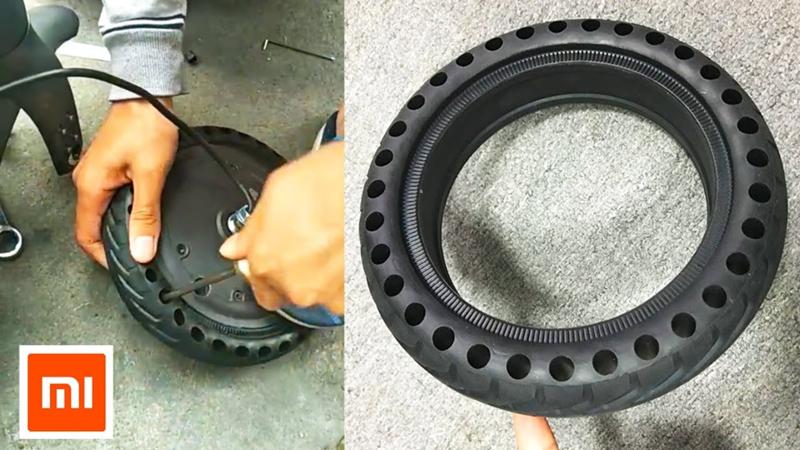 Here it is enough to check the element for contamination or mechanical damage. Kerosene will help clean the bearing from dirt and moisture. If the part is deformed, it must be replaced.
Here it is enough to check the element for contamination or mechanical damage. Kerosene will help clean the bearing from dirt and moisture. If the part is deformed, it must be replaced. Sometimes it happens that the electric scooter does not turn on at all. Then we advise you to read an article on this topic.
Most manufacturers of electric scooters include compact pumps with their devices, with which it is possible to inflate the wheel at any time.
The recommended tire pressure for electric vehicles depends on the user's weight.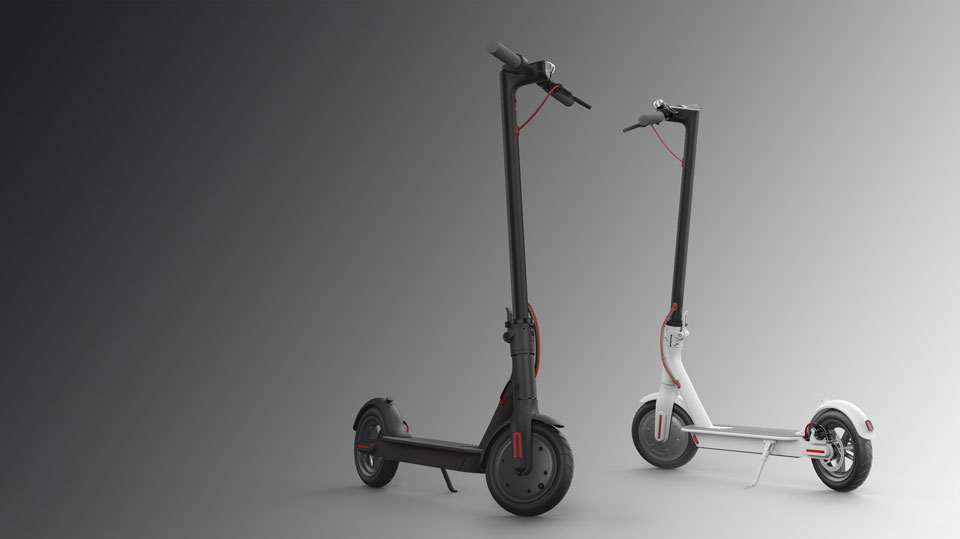 Values should be as follows :
Values should be as follows :
These pressures make the wheels more resistant to punctures and other damage.
Avoiding punctures is very problematic, whether it is an adult electric scooter with large wheels or a children's model. But if you listen to the advice, it is still possible to prevent undesirable consequences. It is important to remember the following points:

The wheel with all its parts will cost about $30.
Before removing a tubeless wheel on a Xiaomi electric scooter or a device from another manufacturer, it will need to be deflated. The wheel itself is removed in accordance with the instructions described above - you need to unscrew all the screws in sequence. And to remove the tire, you will need to insert a flat screwdriver between it and the rim, and then press with your fingers.
No, the wheels must be removed before disassembly, otherwise it will not be possible to remove all the parts.
Modern manufacturers equip the devices with solid and pneumatic wheels. The former are considered more durable and reliable, they are resistant to damage. The latter provide comfort during the trip, as the air in the tires reduces vibration.
This error indicates a problem with the motor wheel wiring.
Removing the wheel of an electric scooter is done by hand using simple tools. This procedure is really important, because it is thanks to it that you can extend the life of the device and not worry about sudden breakdowns along the way.
This procedure is really important, because it is thanks to it that you can extend the life of the device and not worry about sudden breakdowns along the way.
In the life of every scooter driver, there comes a moment when he has to master the difficult science of removing the rear or front wheel of a scooter.
Due to ignorance of the basic rules in this work, many beginners "woe mechanics" manage to break the "eternal" parts of the rear wheel by definition. Whatever they try to unscrew the rear wheel nut and cut it with a chisel and heat it with a cutter and in especially difficult cases “grind”, and in such a way that it’s scary to look at all this later.
In fact, what is so difficult about it? I took a good wrench and unscrewed the nut, but no ... Give them a "grinder" ... One has to agree only that the rear axle nut is tightened from the factory with very great effort, but this is not a reason to pick up a grinder . ..
..
So, put the scooter on the central stand so that the wheels dangle freely in the air, if necessary, remove the muffler and shock absorber, insert a plank between the spokes of the rear wheel, pick up the tools (good ones) and start ...
As mentioned above , the rear axle nut is very tight, so use a very good socket to loosen it. If you unscrew the nut with an old broken head, the result will be the same: merge the edges on the nut, and then everything is “write wasted”. We'll have to pick up the "Bulgarian", with all the consequences ...
[stextbox id="warning"]When you put a plank between the spokes, don't put it where the valve is! Also note that the plank does not rest on the rear brake cable and oil lines (if you have a 2T engine). Did not work out? Try again - it will open! Where the hell is she going to go ... Under the nut there should be a spacer, do not lose it.
Unscrew the additional bracket (if any)
Remove the bracket from the axle
Remember the location of the spacers and finally remove the wheel from the axle
except for little things.